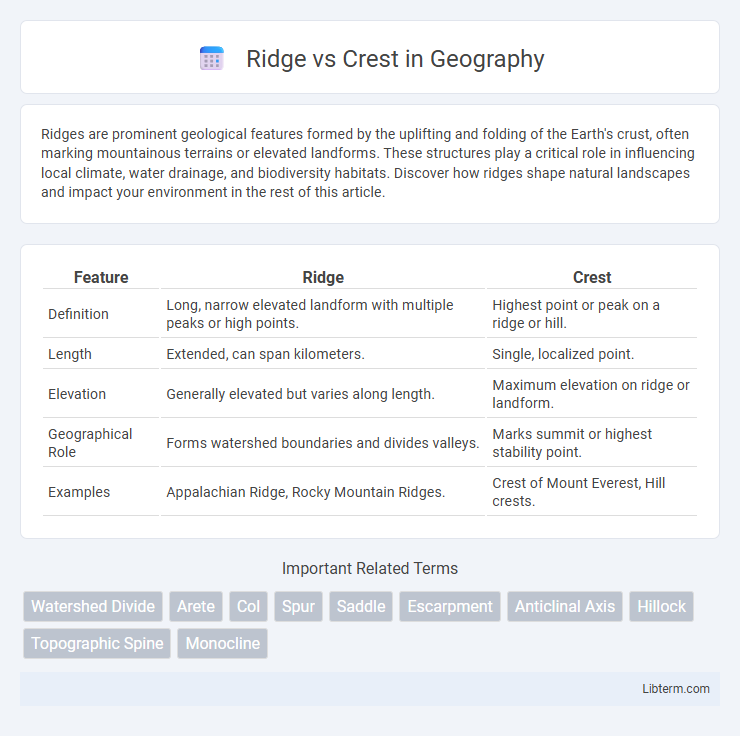Ridges are prominent geological features formed by the uplifting and folding of the Earth's crust, often marking mountainous terrains or elevated landforms. These structures play a critical role in influencing local climate, water drainage, and biodiversity habitats. Discover how ridges shape natural landscapes and impact your environment in the rest of this article.
Table of Comparison
| Feature | Ridge | Crest |
|---|---|---|
| Definition | Long, narrow elevated landform with multiple peaks or high points. | Highest point or peak on a ridge or hill. |
| Length | Extended, can span kilometers. | Single, localized point. |
| Elevation | Generally elevated but varies along length. | Maximum elevation on ridge or landform. |
| Geographical Role | Forms watershed boundaries and divides valleys. | Marks summit or highest stability point. |
| Examples | Appalachian Ridge, Rocky Mountain Ridges. | Crest of Mount Everest, Hill crests. |
Introduction to Ridge and Crest
A ridge is a long, narrow elevated landform often formed by tectonic activity or erosion, creating a continuous crest along its length. The crest refers specifically to the highest point or apex along a ridge or hill, representing a distinct peak in topography. Understanding the distinction between ridge and crest is crucial for geological mapping and landscape analysis.
Defining Ridge: Key Characteristics
A ridge is an elongated area of elevated terrain often formed by tectonic activity or erosion, characterized by a continuous crest line that connects multiple high points. It typically serves as a watershed boundary, influencing the flow of rivers and streams on either side. Unlike a single crest, a ridge extends over a considerable distance, providing natural corridors for ecosystems and human travel.
What is a Crest? Essential Features
A crest is the highest point or peak of a hill, mountain, or wave, often serving as a critical marker in topography and geography. It represents a narrow, elongated ridge at the summit where two slopes meet, characterized by its sharp, often jagged edge. Crest lines are essential for understanding watershed boundaries and influence weather patterns due to their elevation and exposure.
Geological Formation of Ridges
Ridges are elongated landforms often formed by the folding and faulting of the Earth's crust, typically found at convergent plate boundaries where tectonic forces compress rock layers. These geological processes create elevated, linear features composed of resistant rock strata that withstand erosion, distinguishing ridges from surrounding valleys. Ridges can also result from volcanic activity, where lava flows solidify into raised structures, or from differential erosion that leaves harder rock bands elevated as crests along a folded mountain range.
How Crests Occur in Nature
Crests commonly occur in nature as the highest points on waves, mountain peaks, or ridges where elevation reaches its maximum. On ocean waves, crests form due to the wind generating upward movement of water molecules, creating the wave's peak. In mountainous regions, crests appear as the apex of ridgelines, shaped by tectonic activity and erosion over time.
Ridge vs Crest: Main Differences
A ridge is an elongated, continuous elevated landform that extends over a large area, often forming the backbone of a mountain range, while a crest refers to the highest point or peak along a ridge. Ridges typically have a linear shape and can feature multiple crests, with crests representing the specific tops or summits along the ridge. The main difference lies in scale and specificity: ridges are extensive landforms, whereas crests are localized high points on those ridges.
Common Examples of Ridges and Crests
Ridges are elongated landforms often found in mountain ranges such as the Rocky Mountains and the Himalayas, characterized by a continuous elevated crest line that separates valleys. Crests represent the highest points on these ridges, commonly seen in features like the Appalachian Mountains and the Andes, where they form prominent peaks and summits. Both ridges and crests play crucial roles in defining watershed boundaries and influencing local climate patterns.
Importance of Ridges and Crests in Geography
Ridges and crests are critical landform features that influence water flow, soil erosion, and vegetation patterns in geographic regions. Ridges act as natural watershed boundaries, directing rainfall runoff into distinct drainage basins and impacting local ecosystems. Crests, often representing the highest points on ridges, serve as key reference markers for topographic mapping and landscape navigation.
Practical Applications: Where Ridge and Crest Matter
Ridges and crests play critical roles in geography, civil engineering, and environmental planning. Ridges often serve as natural watershed boundaries, affecting water flow and erosion control, making them essential in flood management and infrastructure development. Crests, representing the highest points along a ridge, are crucial in telecommunications for placing antennas to maximize signal range and in hiking for navigation and scenic viewpoints.
Conclusion: Choosing Between Ridge and Crest
Selecting between ridge and crest depends on the specific context of terrain analysis or architectural design. Ridges represent elongated elevations with continuous high points, ideal for drainage and wind exposure assessments, while crests denote the highest peak points, often crucial for visibility and strategic positioning. Understanding these distinctions enables more precise decision-making in environmental planning or structural applications.
Ridge Infographic

 libterm.com
libterm.com